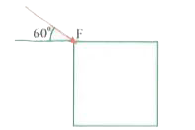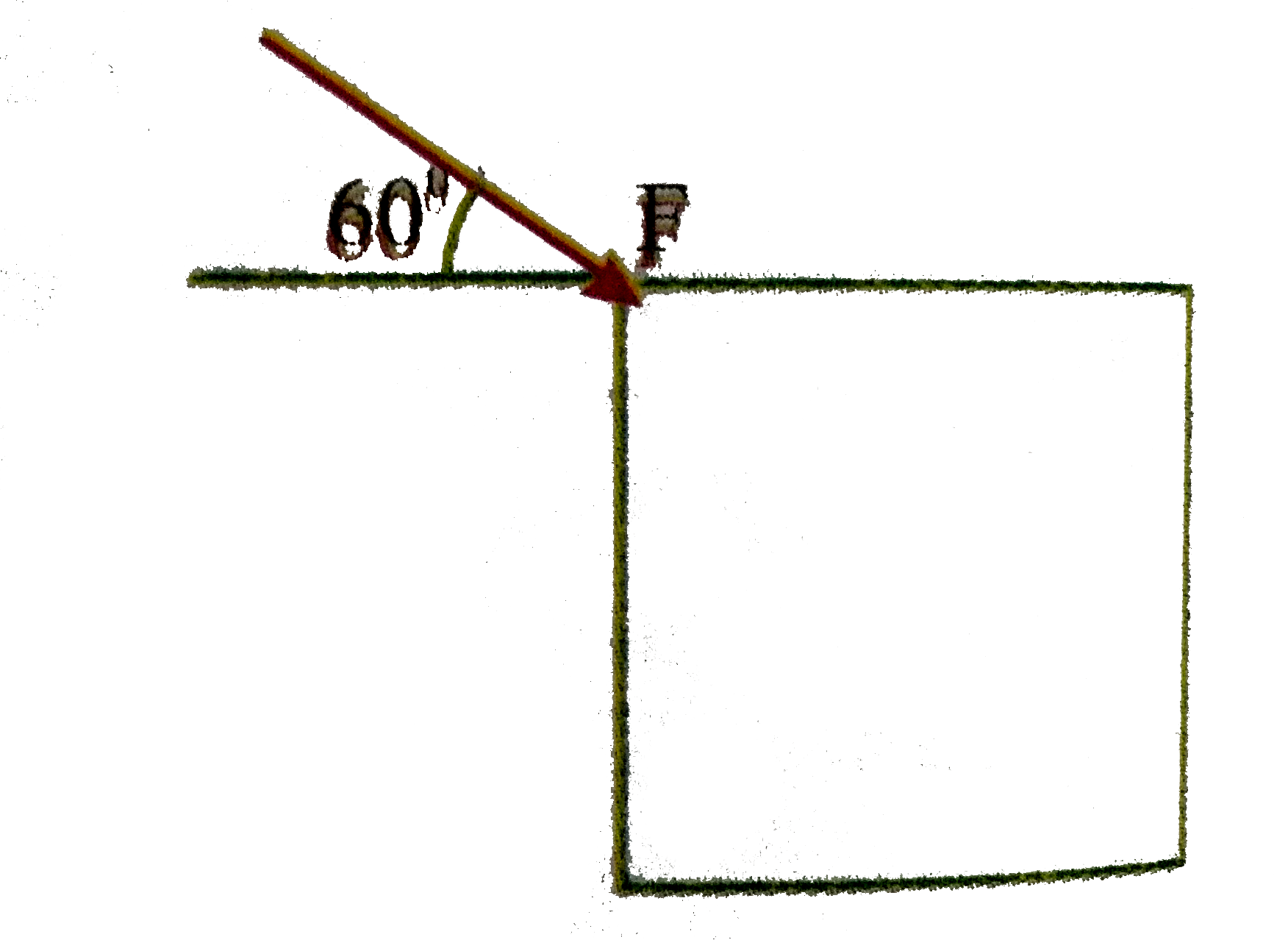A heavy body of mass 25kg is to be dragged along a horizontal plane (mu = 1√3. The least force required is (1kgf=9.8N)
25kgf
2.5kgf
12.5kgf
6.25kgf
The correct Answer is:C
To find the least force required to drag a heavy body of mass 25 kg along a horizontal plane with a coefficient of friction μ=1√3, we will follow these steps:
Step 1: Understand the Forces Acting on the Body
The body experiences:
- Weight W=mg acting downwards.
- Normal force N acting upwards.
- Applied force F at an angle α to the horizontal.
- Frictional force f acting opposite to the direction of motion.
Step 2: Calculate the Weight of the Body
Given:
- Mass m=25kg
- Acceleration due to gravity g=9.8m/s2
The weight W is calculated as:
W=mg=25kg×9.8m/s2=245N
Step 3: Set Up the Equations
The normal force N can be expressed as:
N=W−Fsinα
The frictional force f is given by:
f=μN=μ(W−Fsinα)
Step 4: Apply Newton's Second Law
In the horizontal direction, the applied force Fcosα must overcome the frictional force:
Fcosα=f
Substituting for f:
Fcosα=μ(W−Fsinα)
Step 5: Rearrange the Equation
Rearranging gives:
Fcosα+μFsinα=μW
Factoring out F:
F(cosα+μsinα)=μW
Thus,
F=μWcosα+μsinα
Step 6: Maximize the Denominator
To minimize F, we need to maximize the denominator cosα+μsinα. We can use calculus for this:
1. Differentiate cosα+μsinα with respect to α.
2. Set the derivative to zero to find the angle α that maximizes the expression.
Step 7: Differentiate and Solve
The derivative is:
−sinα+μcosα=0
This leads to:
μcosα=sinα⇒tanα=μ
Given μ=1√3:
tanα=1√3⇒α=30∘
Step 8: Substitute Back to Find Minimum Force
Substituting α=30∘ into the equation for F:
F=1√3×245cos30∘+1√3sin30∘
Calculating cos30∘=√32 and sin30∘=12:
F=245√3√32+12√3
Simplifying the denominator:
√32+12√3=3+12√3=42√3=2√3
Thus,
F=245√32√3=2452=122.5N
Final Step: Convert to kgf
To convert to kgf:
F=122.59.8≈12.5kgf
Final Answer
The least force required to drag the body is approximately 12.5 kgf.
The body experiences:
- Weight W=mg acting downwards.
- Normal force N acting upwards.
- Applied force F at an angle α to the horizontal.
- Frictional force f acting opposite to the direction of motion.
Given:
- Mass m=25kg
- Acceleration due to gravity g=9.8m/s2
W=mg=25kg×9.8m/s2=245N
The normal force N can be expressed as:
N=W−Fsinα
The frictional force f is given by:
f=μN=μ(W−Fsinα)
In the horizontal direction, the applied force Fcosα must overcome the frictional force:
Fcosα=f
Substituting for f:
Fcosα=μ(W−Fsinα)
Rearranging gives:
Fcosα+μFsinα=μW
Factoring out F:
F(cosα+μsinα)=μW
Thus,
F=μWcosα+μsinα
To minimize F, we need to maximize the denominator cosα+μsinα. We can use calculus for this:
1. Differentiate cosα+μsinα with respect to α.
2. Set the derivative to zero to find the angle α that maximizes the expression.
The derivative is:
−sinα+μcosα=0
This leads to:
μcosα=sinα⇒tanα=μ
Given μ=1√3:
tanα=1√3⇒α=30∘
Substituting α=30∘ into the equation for F:
F=1√3×245cos30∘+1√3sin30∘
Calculating cos30∘=√32 and sin30∘=12:
F=245√3√32+12√3
Simplifying the denominator:
√32+12√3=3+12√3=42√3=2√3
Thus,
F=245√32√3=2452=122.5N
To convert to kgf:
F=122.59.8≈12.5kgf
The least force required to drag the body is approximately 12.5 kgf.
Topper's Solved these Questions
- BOOK - DC PANDEYCHAPTER - LAWS OF MOTIONEXERCISE - Objective Question32videos
LAWS OF MOTION
- BOOK - DC PANDEYCHAPTER - LAWS OF MOTIONEXERCISE - Comprehension9videos
LAWS OF MOTION
- BOOK - DC PANDEYCHAPTER - LAWS OF MOTIONEXERCISE - Exercise 8.52videos
LAWS OF MOTION
- BOOK - DC PANDEYCHAPTER - KINEMATICS 1EXERCISE - INTEGER_TYPE15videos
KINEMATICS 1
- BOOK - DC PANDEYCHAPTER - LAWS OF THERMODYNAMICSEXERCISE - Level 2 Subjective18videos
LAWS OF THERMODYNAMICS
Similar Questions
A small body of mass m is located on a horizontal plane at the point O. The body of mass m is located on a horizontal plane at the point O. The body acquires a horizontal velocity v0. Find,
(a) the mean power developed by the friction force during the whole time of motion, if the friction coefficient k=0.27, m=1.0kg, and v0=1.5m/s,
(b) the maximum instantaneous power developed by the friction force, if the friction coefficient varies as k=αx, where α is a constant, and x is the distance from the point O.View SolutionA block of mass √3kg is kept on a frictional surface with μ=12√3. The minimum force to be applied as shown to move the block is
 View Solution
View Solution
Knowledge Check
- Question 1 - Select One
A heavy body of mass 25kg is to be dragged along a horizontal plane (μ = 1√3. The least force required is (1kgf=9.8N)
A25 kgfB2.5 kgfC12.5 kgfD6.25 kgf - Question 2 - Select One
A body of mass 1kg is moving along a straight line with a velocity of 1m/s. The external force acting in the body is
A1NB1 dyneC1JDzero - Question 3 - Select One
A body of mass 25 kg is at rest on a horizontal surface. Minimum horizontal force required to just start the motion is 73.5 N and a force of 49 N is needed to keep the body moving with a constant velocity. What is the coefficient of static friction?
A0.2B0.3C0.4D0.5
A block of mass √3kg is kept on a frictional surface with μ=12√3. The minimum force to be applied as shown the move the block is
 .View Solution
.View SolutionA block of mass m=1/3 kg is kept on a rough horizontal plane. Friction coefficient is μ=0.75. The work done by minimum force required to drag to the block along the plane by a distance 5m is :-
View SolutionA body of mass 10kg is lying on a rough inclined plane of inclination 37∘ and μ=1/2 , the minimum force required to pull the body up the plane is
View SolutionA body of mass 2 kg is being dragged with uniform velocity of 2 m / s on a rough horizontal plane. The coefficient of friction between the body and the surface is 0.20. The amount of heat generated in 5 sec is
. (4.2joule/calandg=9.8m/s2)
 View Solution
View SolutionForce required to move a mass of 1 kg at rest on a horizontal rough plane (μ=0.1 and g=9.8m/s2) is
View Solution

